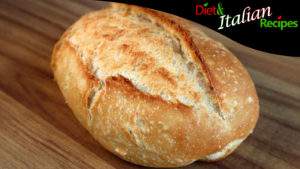Recipe for Homemade Bread: Soft Inside and Crunchy Outside
The recipe for making homemade bread, just like the one made by a baker, with simple and clear instructions. Once the dough is made, it is left to rise and then baked.
Doses for 6 people
Calorie per porzione265kcal
Cost Low
Other details
- Difficulty: medium
- A heat-resistant pot (preferably cast iron) is needed for preparation, capable of withstanding high temperatures.
Ingredients
- 375 g All-purpose flour (11.5 g protein for baking) (13.23 oz)
- 310 g Warm water (10.93 oz)
- 5 g Acrtive dry yeast (or 3 g instant yeast) (0.18 oz)
- 5 g Salt (0.18 oz)
Instructions
How to prepare homemade bread
- To prepare homemade bread, start by mixing the flour and salt in a bowl. In another bowl, dissolve the yeast in warm water. We used this specific flour for baking.
- Using a fork, combine the flour, water, and yeast until you obtain a well-mixed and sticky mixture. At this point, cover the bowl with a cloth and let it rise at room temperature for 12 hours. In summer, approximately 22°C (71.6°F) and 12 hours are sufficient, but in winter, it may take anywhere from 18 to 24 hours due to the lower temperature. It all depends on the room temperature where you leave the bread dough to rise.
- After the first rising time has passed, flour a work surface and pour the dough of our homemade bread onto it. Also, dust the surface of the dough with flour and let it rest for 15 minutes. The dough will be very soft at this point, but do not add any more flour because you haven't made any mistakes! It should be this soft.
- Flatten the dough with your hands and then fold the four sides of the dough onto itself, as if it were a folded napkin. Take a kitchen towel, dust it with flour, and place the loaf with the folded sides down. Cover it with the towel and let it rise for 1 hour, or even better, 2 hours if you have the time. At least 30 minutes before baking, preheat the convection oven to 250°C (482°F) with the pot inside (preferably a cast iron pot with a lid for bread), so that it reaches the same temperature as the oven.
- When it's time to bake, take the hot pot and pour the well-risen dough of our homemade bread into it. The folds we made earlier should be facing upwards. Cover the pot with the lid and bake for 30 minutes. Remove the lid and continue baking with the pot uncovered using the static oven for another 10-15 minutes. Check the color of the crust of your homemade bread to determine when it's ready.
- Once the homemade bread is well baked, remove it from the oven and place it on a cooling rack to cool down. We must wait at least an hour before slicing it, otherwise, it will be chewy and less crunchy. During the cooling process, if you listen closely to the bread (without thinking you're crazy), you will hear it "sing." Some crackling indicates the moment when the steam from the crumb escapes through the micro-cracks in the crust. These micro geysers are essential for achieving a nearly perfect loaf, just like the one made by a baker. If you cut the homemade bread too soon, all the steam will come out at once, resulting in an undercooked loaf with a gummy crumb. It's better not to do that, especially since you've waited more than a day for this moment! After it has cooled for an hour, you can already taste it. It's your homemade bread!
Watching calories
The calorie information refers to 100 g (3.5 oz) of homemade bread.
